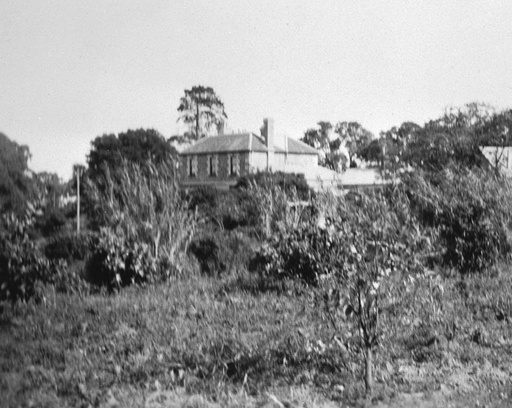Woodforde House
So important to the area is Woodforde House that it is on the State Heritage listing. It was built in 1856 by William Uren, who had arrived in South Australia from Helston in Cornwall. He arrived with his family on board the William Money. The family of seven left England but only six arrived in Adelaide. An infant named Alfred had died, and was buried at sea. The family were listed as Wren/Uren on the passenger manifest1. The trip to Adelaide was not uneventful; there were a number of deaths, including one by poisoning2. An enquiry was held into the death, and accidental death was the finding. The Uren family consisted of William 31, Ann 32, Honor 10, Christian 9, William 4, and Jane 1.3

WOODFORDE HOUSE photo courtesy of State Library of South Australia B62871.
Distant view of Woodforde House at Magill, fruit trees forming part of a new orchard can be seen in the foreground
Mr Uren bought the land for his new home, when Captain Duff sub divided his 720 acre estate, section 342, known as Woodforde and Finchley. He purchased 50 acres, and built an eight room house on it, in 1856.4 The house was named Woodforde House and remained in the Uren/Nightingale family until March 1977.
Mr Uren ran a very successful boot and shoe importing and retail shop, in Rundle Street Adelaide. In March 1889 Mr Uren died aged 72. Woodforde House then passed to his only son Joseph Mortimer Uren. Joseph Uren was married to Emily Ellen Uren nee Wells, daughter of the Rev. W.P. Wells of Brighton Victoria.5 Joseph was employed by the Bank of South Australia. In 1900 only 11 years after the death of his father, Joseph also died aged just 40 years. Joseph and Ellen had only one child, Gertrude Anna Uren. In his will, Joseph had stated that the house was to go to Gertrude, and the income from the house was to go to his widow. When Gertrude attained the age of 21 years, the income was to be shared between his daughter and his widow.
In 1911 Gertrude Anna Uren married William Allen Nightingale from Hull in England6. The house remained in the Nightingale family until sold in 1977. The house remains in private hands to this day.
Researched and compiled by Jim Nelson, a volunteer with the Campbelltown Library “Digital Diggers” group.
If you have any comments or questions regarding the information in this local history article, please contact the Local History officer on 8366 9357 or hthiselton@campbelltown.sa.gov.au
References
- Cummings, D., 2010. "William Money" 19848-49 by Diane Cummings. [online] Bound for South Australia Collection. Available at: https://bound-for-south-australia.collections.slsa.sa.gov.au/1849WmMoney.htm [Accessed 17 March 2021].
- Cummings, D., 2010. "William Money" Poison by Diane Cummings. [online] Bound for South Australia Collection. Available at: https://bound-for-south-australia.collections.slsa.sa.gov.au/1849WmMoneyPoison.htm [Accessed 17 March 2021].
- Cummings, D., 2010. "William Money" 19848-49 by Diane Cummings. [online] Bound for South Australia Collection. Available at: https://bound-for-south-australia.collections.slsa.sa.gov.au/1849WmMoney.htm [Accessed 17 March 2021].
- Campbelltown City Council SA , Donovan & Associates, History & Historic Preservation Consultants. 2012. Magill Village An historical overview. [online] Available at: https://www.campbelltown.sa.gov.au/__data/assets/pdf_file/0019/234910/Magill-Village-An-historical-overview.pdf [Accessed 17 March 2021].
- The Express and Telegraph (Adelaide, SA : 1867 - 1922) Wednesday 11 November 1885 p 4
- Evening Journal (Adelaide, SA : 1869 - 1912) Wednesday 22 November 1911 p 1
